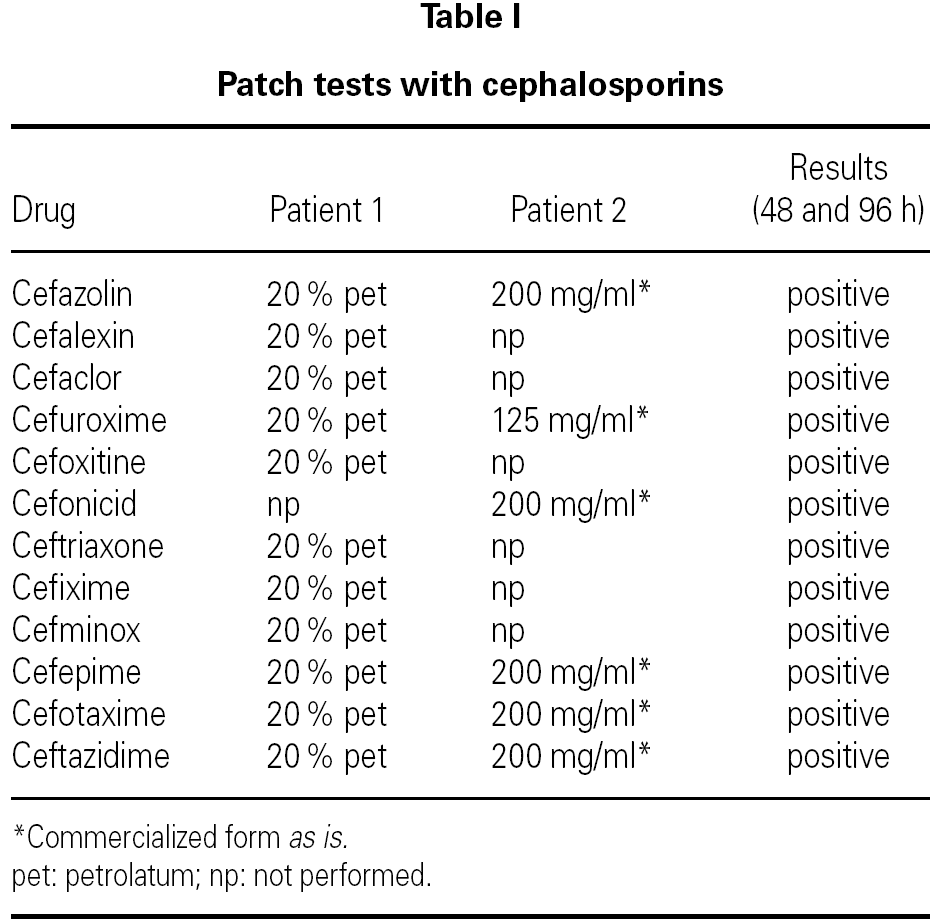INTRODUCTION
Few studies have reported delayed hypersensitivity reactions to systemically administered cephalosporins. The most typical clinical manifestation is a maculopapular rash 1-6. Diagnostic procedure and extracts for these reactions are not standardized, and little is known about the extent of crossreactivity among different cephalosporins. We report 2 cases of delayed reactions due to cephalosporins suggesting erythrodermia, and confirmed by patch tests. We have not found this clinical presentation in the literature for delayed reactions with cephalosporins.
CASE REPORTS
Case 1
A 80-year-old man was treated orally with cefuroxime (250 mg twice a day) because of a respiratory infection. Two days after starting this treatment, he developed generalized pruritus and erythema involving all the skin. He was admitted to hospital. Laboratory testing revealed leukocytosis (15400/mm 3) with eosinophilia (9 %). This drug was stopped and antihistamines and corticosteroids were administered. The patient improved slowly, observing a slightly superficial desquamation 5-6 days later. The complete resolution of the symptoms occurred in 10 days. A skin biopsy at the second day of the eruption showed moderated acanthosis and hyperkeratosis, and lymphohistiocytic infiltrate in the dermis with numerous eosinophils. The patient had not presented adverse reactions to drugs previously and he had no history of allergic diseases. He did not remember if he had taken cefuroxime before, and he has avoided betalactams after the reaction.
Case 2
A 66-year-old woman began treatment with cefazolin i.m. (500 mg/12 h) and metamizole (500 mg/8 h orally) after the implantation of a knee prosthesis. Forty-eight hours later she presented with a pruritic rash that started on her trunk and then spread to her entire cutaneous surface, including her palms and soles. Physical examination at fourth day revealed widespread fine scaling and diffuse erythema. She gradually improved after discontinuation of both drugs and systemic administration of antihistamines and corticosteroids in 7 days. She had taken cephalosporins 8 years before and she remembered a similar reaction with ceftazidime. She has tolerated amoxycillin and metamizole after the last episode without problems. The patient had no history of skin disorders or atopy.
METHODS AND RESULTS
Two to four months after the reactions, we studied both patients after obtaining informed consent. Prick tests with penicillin G (10,000 UI/ml), amoxycillin (20 mg/ml), ampicillin (20 mg/ml) and cephalosporins (ceftazidime, cefazolin, cefuroxime, cefonicid, cefotaxime and cefepime at 2 mg/ml) 7 were negative. No specific IgE antibodies against the same allergens were found. Prick and intradermal tests with penicillin determinants (PPL and MDM) proved negative. Intradermal tests with ceftazidime and cefazolin (2 mg/ml) were positive in case 2 at delaying reading (48 h). Patch tests (20 % pet) on healthy back skin using benzylpenicillin, ampicillin, amoxycillin, aztreonam and imipenem were negative (at 48 and 96 hours). Patch tests with cephalosporins were performed with commercialized forms diluted at 20 % in pet (patient 1) 8 or using the marketed preparations as is (patient 2) 3,4 on the back (normal skin) using Curatest® (Lohmann Rauscher, Germany) covered by Mefix® (Mölnlycke Health Care AB, Sweden) with 48 hours of occlusion. All of them resulted positive (table I), but negative in 10 control patients. Controlled administration of amoxycillin (750 mg orally), benzylpenicillin (1.000.000 UI im), aztreonam (500 mg im) and imipenem (250 mg im) on different days was well tolerated for both patients.
DISCUSSION
Nonimmediate reactions are those occurring more than 1 hour after drug administration. The main nonimmediate reactions are maculopapular or morbilliform exanthems, although other reactions are possible as urticaria/angioedema, exfoliative dermatitis, acute generalized exanthematous pustulosis, Stevens-Johnson syndrome, toxic epidermal necrolysis, etc. The mechanisms involved in these reactions seem to be heterogeneous 7. Regarding cephalosporins, only a few articles report about these reactions and in all of them maculopapular rashes are observed 1-6.
We describe 2 patients who suffered an erythrodermic reaction several days after beginning cephalosporin therapy (cefuroxime in the case 1, and cefazolin and ceftazidime in the case 2). We have not found in the literature previous cases reporting delayed hypersensitivity reactions with ceftazidime, neither erythrodermia as clinical presentation of delayed reactions to cephalosporins.
Our cases, as well as others from other authors, demonstrate the usefulness and safety of patch tests in the diagnosis of delayed hypersensitivity to cephalosporins. Moreover, patch tests prove useful to detect or rule out cross-reactivity to other betalactam drugs and among cephalosporins 1-5,7. As in other papers, our patients showed positivity to cephalosporins with different side chains but no to other betalactams 3,4. Romano et al suggest that the response could be directed toward a determinant shared by cephalosporins (probably at the core portion of the molecule, rather than at their side chains), but not by other betalactams 4. On the contrary, Martin et al find a positive result only for the cephalosporin responsible of the reaction (cefonicid) 2. Studies on the cephalosporins as allergens are scarce, and very few have been dedicated to the determinants responsible for allergic reactions. The dihydrothiazine ring and side chains have been identified as antigenic structures, but the questions on allergenic cross-reactivities among cephalosporins, and between cephalosporins and penicillins cannot be answered with confidence.
In summary: 1) We report 2 cases of delayed hypersensitivity reactions due to cephalosporins presenting as erythrodermia. 2) Epicutaneous tests have been useful for the diagnosis. 3) Both patients proved positive to all cephalosporins and negative to other betalactams.
Correspondence:
Dra. M. Angeles Gonzalo-Garijo
Hospital Infanta Cristina. Sección de Alergología
Ctra. de Portugal, s/n
06080 Badajoz (Spain)
Fax: + 34 924 21 81 10
Phone number: + 34 924 21 81 00
E-mail: mgg01ba@saludalia.com






